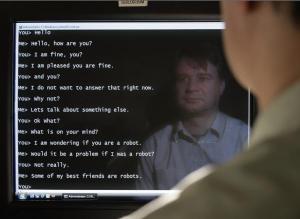At a major artificial intelligence competition at the University of Reading on 12 October, machines have come close to imitating human communication.
As part of the 18th Loebner Prize, all of the artificial conversational entities (ACEs) competing to pass the Turing Test have managed to fool at least one of their human interrogators that they were in fact communicating with a human rather than a machine. One of the ACEs, the eventual winner of the 2008 Loebner Prize, got even closer to the 30% Turing Test threshold set by 20th-century British mathematician, Alan Turing in 1950, by fooling 25% of human interrogators.

© University of Reading/Diem PhotographyACE conversing with human interrogator.
Top machines from around the world were entered into the competition and following extensive scrutiny these were whittled down to the five best for the 12 October finale. During the Turing Test at the University of Reading, the ACEs competed in a series of five minute long, unrestricted conversations with human interrogators, attempting to pass themselves off as human. The interrogators did not know whether they were conversing with a human or a machine during the test.
Alan Turing first devised the imitation game known as the Turing Test in 1950. In his seminal paper "Computing, Machinery & Intelligence", he postulated that, "If, during text-based conversation, a machine is indistinguishable from a human, then it could be said to be 'thinking' and, therefore, could be attributed with intelligence".¹
Organiser of the Turing Test, Professor Kevin Warwick from the University of Reading's School of Systems Engineering, said: "This has been a very exciting day with two of the machines getting very close to passing the Turing Test for the first time. In hosting the competition here, we wanted to raise the bar in Artificial Intelligence and although the machines aren't yet good enough to fool all of the people all of the time, they are certainly at the stage of fooling some of the people some of the time.
"Today's results actually show a more complex story than a straight pass or fail by one machine. Where the machines were identified correctly by the human interrogators as machines, the conversational abilities of each machine was scored at 80 and 90%.² This demonstrates how close machines are getting to reaching the milestone of communicating with us in a way in which we are comfortable. That eventual day will herald a new phase in our relationship with machines, bringing closer the time in which robots start to play an active role in our daily lives"
The programme Elbot, created by Fred Roberts was named as the best machine in the 18th Loebner Prize competition and was awarded the $3000 Loebner Bronze Award, by competition sponsor Hugh Loebner³.
Notes:¹The Turing Test held at the University of Reading has followed the original test as outlined by Alan Turing in 1950. Under the official criteria of the Turing Test, a machine that fools more than 30% of the human interrogators is deemed to have passed the test.
² Each of the machines identified as a machine by human interrogators received at least one 80-90% conversational ability score
³The Loebner Prize is awarded by Hugh Loebner, Sponsor of the annual Loebner Prize for Artificial Intelligence.

Reader Comments
to our Newsletter